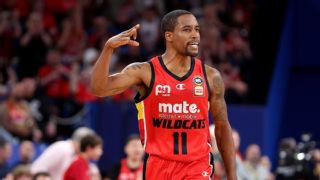|
Every week, ESPN's Olgun Uluc runs through what's catching his eye across the NBL, and takes you inside the conversations trickling around the Australian basketball ecosystem. This week, he looks at the two Wildcats that unlocked the MVP, an All-NBL First Team smokey, and the Aussie making waves at a powerhouse college. 
'It's about making Bryce's life easier'November 4, 2023 marked a very clear, season-altering turning point for the Perth Wildcats. A game against the Adelaide 36ers was a mere vessel for a sentiment that would change the fortunes of their entire season. It was when we saw a full and unabashed embrace of the Wildcats' connectors. Up until that point Bryce Cotton -- widely considered the NBL's most feared offensive threat -- was in the midst of an almighty slump. The shots he was taking were tougher than ever -- leading to career-worst splits -- and there were real questions raised about if this was a regression from the all-time great, or if the Wildcats just needed to alter their processes to make life easier for him. Enter Jesse Wagstaff and Hyrum Harris. For the longest time, connecting players were always on the floor with Cotton to facilitate, complement, and supplement his supreme talent. That wasn't the case to open this Wildcats season, which can largely explain Cotton's poor start, and ultimately the team's overall struggles. Wagstaff had multiple DNP-CDs over the first quarter of the season, while Harris was scarcely utilised. 
For that November 4 game, John Rillie threw Harris into the starting lineup for Jordan Usher -- a role he would then continue to assume on a consistent basis -- and Wagstaff was involved in a more significant way. It worked. It took less than five minutes for a very telling possession to take place; Harris skied for an offensive rebound, pitched it back to Cotton, immediately set an on-ball for him to get his teammate a good look at a three, then put back the miss. There was clearly more flow, and Cotton would pop off for 29 points. The team's processes seemed far more healthy, balanced, and sustainable. That trend would continue for the remainder of the season, and, in a series of events that ended up being demonstrably causal, Cotton would proceed to embark on a scoring tear that's led the once-2-5 Wildcats to a 16-9 record going into the final rounds of the season. All Cotton needed was a connector. "It's easy to fall into the habit of giving Bryce the ball and sitting and watching, because he's so talented," Damian Martin, a Wildcats legend who played alongside Cotton for multiple seasons, told ESPN. "All of a sudden, you bring in Hyrum and Jesse, and they're setting screens away from the ball and setting double drags, they're getting out in the running lanes. They're doing all the little things that are easy to do, but also easy not to do, and brought out the best in Bryce." Martin was a connector for Cotton during their time sharing the backcourt, before Mitch Norton took over the mantle. See, to win in the NBL -- or, to be honest, any basketball game -- it's sometimes important to not completely trust intuition. Putting all of your 'talent' on the floor and hoping for the best is generally never as effective as finding balance within a group. It's why it shouldn't come as a surprise that, according to SpatialJam, the Wildcats' nine most effective three-man lineups include one of Harris or Wagstaff. "I'll try to get Bryce open shots, but I'm also trying to get Kristian Doolittle open shots, I'm trying to get Tai [Webster] and Ush downhill," Harris told ESPN. "It's more just: how can I create easy scores for all of my teammates? The biggest thing is, you have to understand Bryce Cotton is going to be guarded the most heavily in the whole league. So, how can I use that to my advantage? They're gonna switch early, so I'm gonna screen my own man. I see Bryce in transition, so I'll try to get him matched up on a big. It's the little things." The key to excelling in that role is sacrificing personal glory for the betterment of the team. Setting a drag screen, or sprinting rim to rim, or recklessly crashing the offensive glass is nowhere near as sexy as a pull-up jumper or isolation size-up, but it's the dirty work that needs doing. "It's about making Bryce's life easier," Wagstaff told ESPN. "We'll do whatever that is. He obviously, and rightfully so, gets a lot of attention from opposition teams. So, setting screens in transition, hand-offs; Hyrum makes a lot of good decisions, and a lot of them involve Bryce." Wagstaff is in Harris' ear constantly, on how to continue to excel in the role. Before games, the 37-year-old will pull his teammate aside for a brief chat -- "like a: 'hey, you did this well last game, keep doing that'" -- and will drop nuggets of advice during practices, too. "Recently, it's been trying not to pick up early fouls, because I've been struggling with that a bit," Harris said. "He's always dropping little hints and bits of advice." The decision for Rillie to lean into his two connectors made Martin hearken back to a former Wildcats head coach. "It's a Trevor Gleeson analogy," Martin said. "You've got to recruit the right pieces of the jigsaw puzzle so they fit together. I don't think they had them fitting together at the start of the year. They've brought out the best in their MVP but, more importantly, each one of the players is now playing to their strengths and that comes down to knowing their role, embracing their role, and playing it to the best of their ability. "BC will be this year's MVP, but I think you've gotta credit Jesse and Hyrum for the change they brought to the team, and then everybody else has jumped on."
Jack McVeigh's All-NBL First Team case Discussions around this season's All-NBL First Team usually go something like this. Cotton and Chris Goulding are locks. You have the presumptive MVP, along with the best performing player on the best team in the NBL. Then, names like Anthony Lamb and Mitch Creek are thrown in; it's tough to ignore the overall production and efficiency of both forwards. Then, there's a pause. One corner of the discourse will bring up wanting a true centre in there, so Isaac Humphries' name is invariably brought up. Another will suggest Jaylen Adams, whose counting stats are surprisingly still quite solid, on a team that could still finish in the top four. Gary Clark is also making a very good case for himself. Other names often brought up include Parker Jackson-Cartwright, Milton Doyle, and Patrick Miller. There is a sleeper candidate, though, and that's Jack McVeigh. The counting stats are enough to have him in the conversation -- 16.5 points, which is the same as Clark, and 5.2 rebounds per game, while shooting an impressive 52 percent from the field and 36.9 percent from downtown -- but it's his impact on winning that helps his case the most. Going into the penultimate round of the NBL season, McVeigh leads all players in overall plus-minus, with a +193. The next best is his teammate, Jordon Crawford, with +164. With McVeigh, there are some similarities to the way Xavier Cooks operated during his MVP season last campaign; not with his play style, but with his impact. McVeigh is a chameleon, shapeshifting to help his team win. If the team needs a scoring lift, he can step into that with ease as one of the best three-level scorers in the NBL. When it's time for Doyle and Crawford to take the reins, McVeigh has the capacity to step into more of a connecting, off-ball role to supplement them. All of this is value of a kind; perhaps not the sexy stuff that attracts accolades, but absolutely worth taking into consideration. The JackJumpers are currently 14-12 on the season, making them only one of three teams with a winning record. They're a team that probably deserves to have representation in the All-NBL First Team, and McVeigh has a good argument as their -- and perhaps the league's -- most consistent impacter of winning basketball. I'm still undecided on whether I subscribe to the argument, but it's, without question, a reasonable one to make.
Johnny Furphy's stocks are rising When Melbourne's Johnny Furphy joined the University of Kansas, there was an expectation that, as a late bloomer when it came to his rise to being an elite prospect, it may take some time for him to find his footing at the college level. It only took about two and a half months. The 6'9 wing's recent stretch of games has been something to behold. Prior to his four-point effort against Kansas State on Tuesday, Furphy had scored in double digits in six straight games, averaging 15.7 points and 7.5 rebounds per game over that stretch, while shooting 16/29 from downtown. While the game against Kansas State was a back-to-earth outing for Furphy, it was a rarity in what has been an extremely impressive stretch of basketball from the Australian freshman. Furphy was always regarded as a probable future NBA guy but, naturally, his recent play has raised questions about that timeline, and whether it may be expedited. In Furphy, we have a big, long, athletic wing who's currently shooting 40.5 percent from downtown on 3.6 attempts a game... at one of the biggest schools in the nation. He's the prototypical NBA wing and, as of late, has been producing like someone who should be drafted sooner than later. Now, there are still questions about his capacity on the defensive end, and whether this recent stretch is just a purple patch. NBA teams will want to see more sample size on the jump-shot before making any sort of definite declaration that he's a clear 2024 guy. Furphy being a two-and-done still feels like the most realistic outcome here, but the fact that it's even a conversation points to his growth and development over the last 12 months, and how high his ceiling may actually be.
My favourite plays of the week The Tasmania JackJumpers have held their hat on team defence over the years. Here's a good example of it. Milton Doyle is so crafty. There's a lot of skill in the touch Josh Green puts on this lob. And here's some great hustle from Green. Stats for this column were sourced by RealGM and SpatialJam
|
